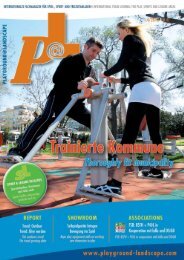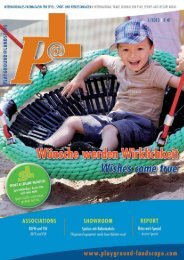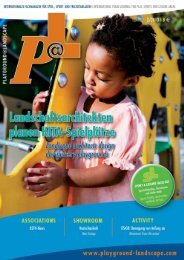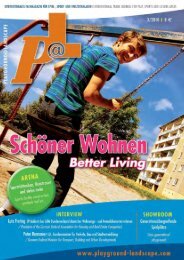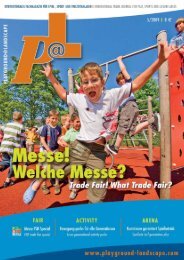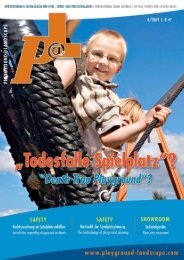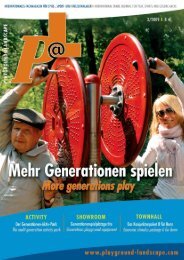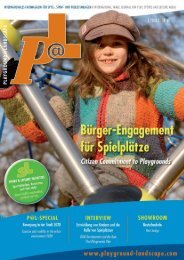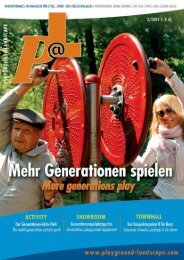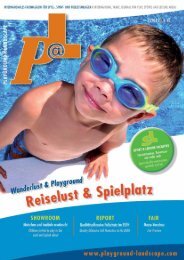School playgrounds - Playground@Landscape
School playgrounds - Playground@Landscape
School playgrounds - Playground@Landscape
Sie wollen auch ein ePaper? Erhöhen Sie die Reichweite Ihrer Titel.
YUMPU macht aus Druck-PDFs automatisch weboptimierte ePaper, die Google liebt.
“Exerting yourself<br />
sensually and voluntarily”<br />
By Dr. Dieter Breithecker, Bundesarbeitsgemeinschaft<br />
für Haltungs- und Bewegungsförderung e. V.<br />
(national association for the<br />
promotion of posture and exercise)<br />
Exercise – a law of nature,<br />
on the school playground too.<br />
Unlike us adults, “health” or “fitness” isn’t enough of a reason for<br />
children to exercise. Children exercise because they are curious about<br />
wanting to discover their environment and, above all, because exercise<br />
is an evolutionary conditional “law of nature”. This “law of nature”<br />
first allows the positive support of complex – i.e. physically reciprocal –<br />
mental, psychological and emotional development processes.<br />
Over the years each generation has left its mark on the way in which<br />
children develop. For millions of years, the person, among others, is<br />
“trained” to walk or to climb, and is also trained on different changing<br />
postures such as lying or crouching on the floor. This principle of evolution<br />
still applies today. For this reason children possess a natural urge<br />
to “exert themselves sensually and voluntarily”. They are only able to<br />
unfold their complex potential because the environment puts them in a<br />
situation to “tackle” a challenging and varied “problem”.<br />
In recent decades, it hasn’t been as easy for children to live out the spontaneous<br />
urge to exercise as prescribed by nature. A restrictive change in<br />
their social and spatial everyday world, on the one hand; but also hasty,<br />
excessive safety measures, standards as well as overprotective parents or<br />
guardians frequently hinder or prevent the varied and boundarypushing<br />
physical activities of the children. We have discovered from<br />
prevention science, however, that variable and complex patterns of<br />
behaviour – as is the case with children if they are able to exercise spontaneously<br />
and are not just made to move by adults - stand for healthy<br />
physical and mental functions of interaction and, thus, development<br />
processes. Children in the first 12 to 13 years of their lives have, as<br />
part of their highly-sensitive sensor motor and brain-physiological<br />
differentiation phase (“neurogenesis”, “synaptogenesis” / neologism and<br />
interconnection of nerve cells) a natural need for diverse and physical<br />
challenges.<br />
Empirical studies verify that, in relation to the baseline situation,<br />
a physically more-appealing environment (“enriched environment”)<br />
requires an interactive inter-relation of physical, mental and social<br />
development processes on a sustainable basis and is, thus, encouraging<br />
(Ickes et al. 2000). Children perceive their environment in a different<br />
way to adults. Children exercise in their own very special, specific world<br />
of investigation and experience. “The child is a playful, physically-active<br />
creature. Everything that he or she learns, does and understands, is<br />
directly associated with his or her ability to approach matters in an<br />
exercise-oriented and playful manner and continue to develop through<br />
experiences of gameplay and exercise” (Hildebrandt 1995, 75).<br />
Develop requires physical challenges<br />
This important recognition is supposed to be reflected in “meaningful”,<br />
Foto rechts: Den Weg sicher planen, jeder nach seinen<br />
Fähigkeiten („Seilparkour“, Corocord Raumnetz GmbH)<br />
Photo right: Planning to make the path safer, each to their own abilities<br />
(“Rope Parkour”, Corocord Raumnetz GmbH)<br />
(i.e. sensor motor) sophisticated areas of demand. An area which is<br />
oriented on the children’s needs, which<br />
● stimulates children’s curiosity-controlled exploratory and<br />
discovery behaviour,<br />
● facilitates varied tactile, vestibular, kinaesthetic experiences,<br />
● develops risk competence through their own daring exploits<br />
in marginal situations,<br />
● fosters the need to self-plan and design, by means of<br />
open spaces, and promotes the children’s self-activity<br />
and creativity in appealing conditions,<br />
● comprehensibly promotes the motor development through<br />
the experience of complex basics types of activities,<br />
● meets the performance prerequisites thanks to a differentiation<br />
of the challenges and a willingness to take calculable risks,<br />
● promotes social learning through problem definitions,<br />
which require mutual, coordinated action and planning.<br />
“Along the way” children learn to control their bodies, acquire skills and<br />
abilities as well as developing dexterity. In addition, a self-concept in<br />
relation to increased exercise skills has a positive effect on the acquisition<br />
of fundamental core competences such as self-confidence, self-awareness,<br />
self-esteem, risk assessment and risk evaluation as well as the<br />
ability to keep oneself safe. Children always need the feeling of having<br />
managed it and having overcome their fears. Boring <strong>playgrounds</strong> are bad<br />
for children, according to Ellen Sandseter, psychologist at the Norwegian<br />
Queen Maude University College, as they can impede emotional development.<br />
Because, according to Sandseter, children need stimulating<br />
confrontation with height and speed in order to overcome fears later on.<br />
Worrying about our children. Overprotection<br />
minimises opportunities to develop<br />
Despite all these insights, everyday exercise seldom appears enchanting.<br />
It lacks child-oriented “areas of exploration”, which allow children to<br />
discover movement problems without supervision and monitoring and<br />
to come up with solutions to these problems. It’s mostly the adults who<br />
shape and define the entire environment of the children. “With the number<br />
of overcautious parents, there is also an increase in the number<br />
31



